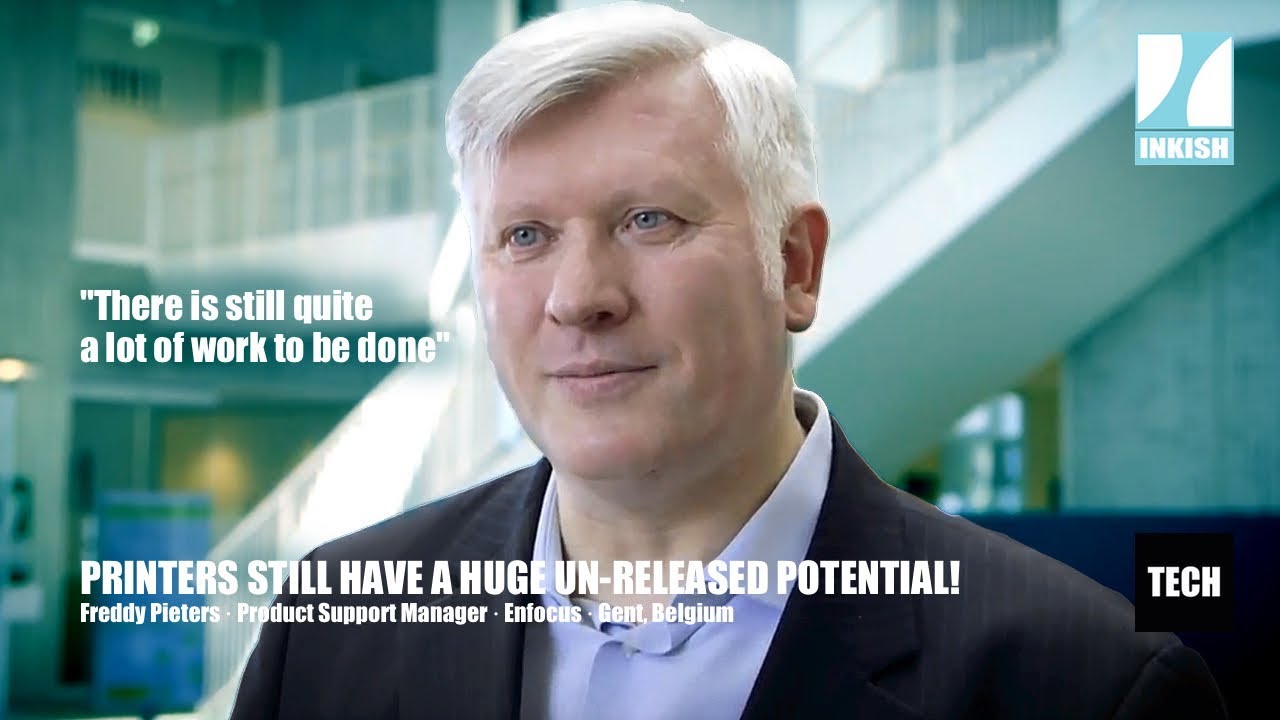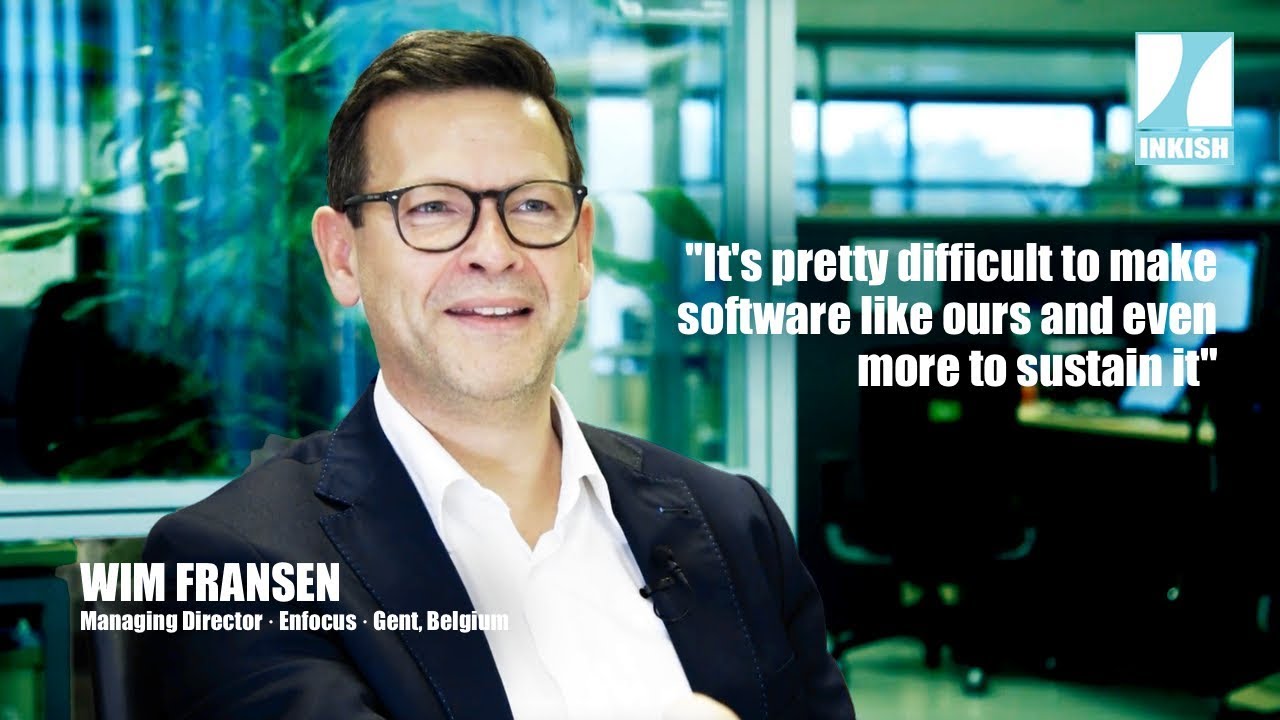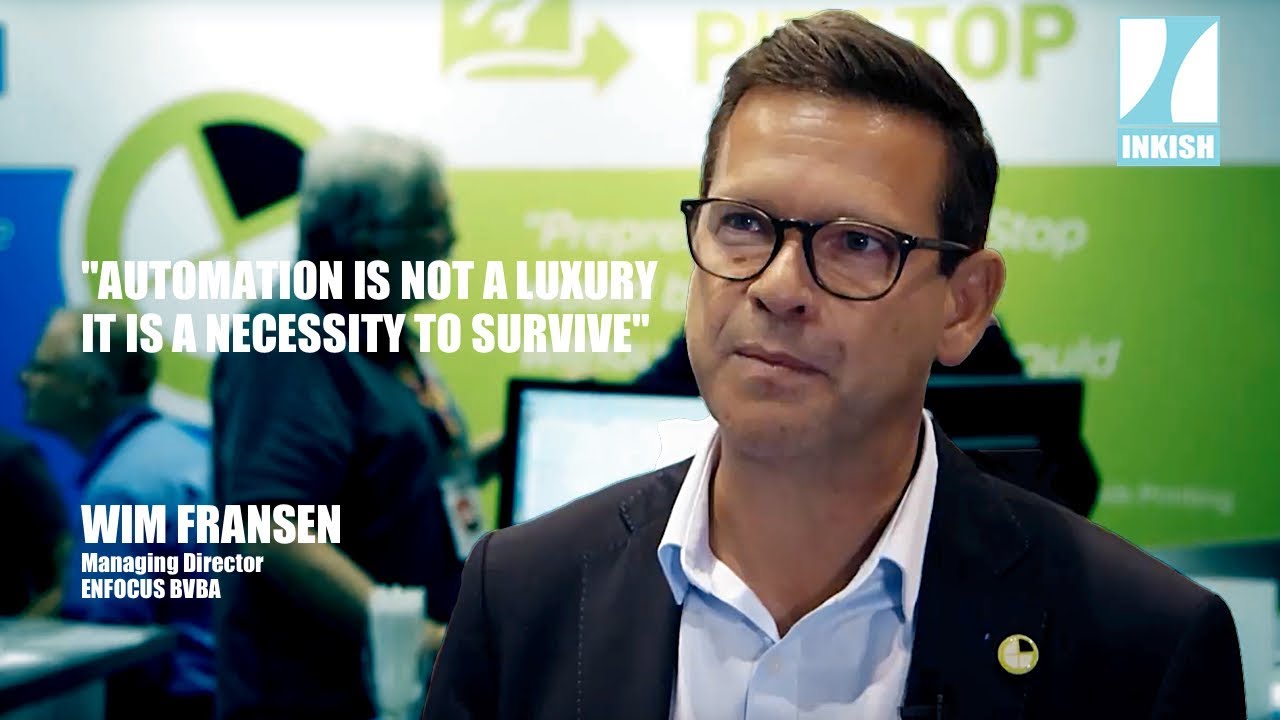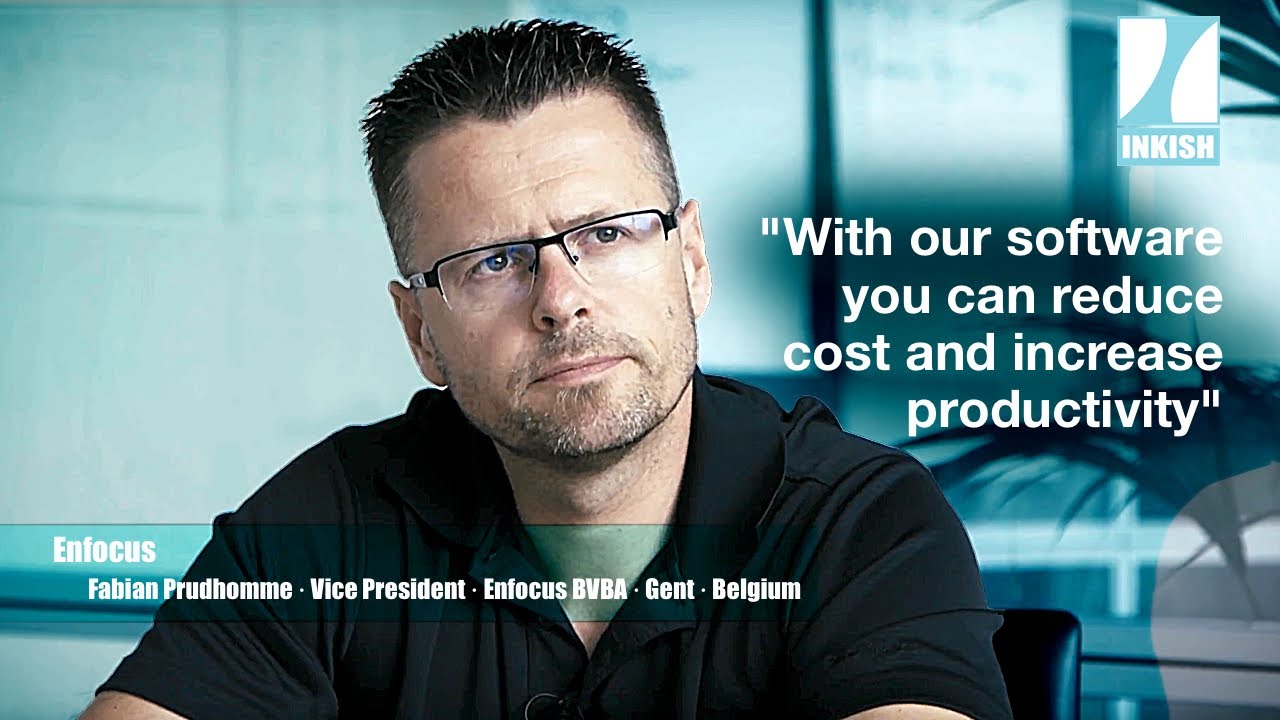Why Everybody Needs Automation · Toon Van Rossum · Enfocus · Gent, Belgium
Many believe automation is only for the bigger or for the few. In this interview, we asked Product Manager Toon Van Rossum from Enfocus why automation is something everybody should consider. We actually ask Toon Van Rossum the same question three times but in perspective; the small printing company, the medium size printing company and finally the large printing company and well – listen to Toon Van Rossum’s answers and consider whether this applies to you and your printing company!
So, a lot of people look at Switch as just a workflow. But in reality I think it’s a bit more than that, it’s a complete automation platform. And there are two ways of getting Switch to work, you can work with one of our integrators, who will work with you to build exactly what you need. Or you can try, figure it out yourself, and in that case it’s really just a box of Lego, and you just build stuff, play around, build exactly what you need, and build your automation just like that.
So, it can go from very simple things, that are just drag and drop, but Switch also allows you to go very advanced. If you know about databases, if you know about scripting, you can script your own solutions and add them to your building blocks in Switch. So if it’s not available out of the box you can still script it, if you have the knowledge, either internally or outsource it. So, it helps you from very basic things, just drag and drop, if you wanna go more advanced it’s possible, and you can build whatever you want that way.
So before the Enfocus app store, there were two ways of integrating with Switch. One was, as I mentioned before, scripting yourself, and building something uniquely that you need. And the other was to, for us, Enfocus, to partner with third parties and other vendors in the industry, and have them create a solution to integrate with Switch.
But what we noticed is that a lot of our customers, they wrote their own scripts, but they were also useful for other customers, and we wanted to provide them with a platform to maybe sell these scripts, make some money off it, and share the solutions that they have with other customers worldwide. And that’s why we came up with the app store, so our integrators, our customers, they can create their own solutions, upload it to the app store, and sell it to our entire install base.
The app store, for us, is not about earning money for Enfocus. It’s about giving the developer, the integrator, the opportunity to make money themselves, not for Enfocus. But indeed it’s … Because if you have to outsource a certain solution, it can cost you a lot more money than if someone who already has it, and created it, to share it and make it available for you.
We have a lot of free apps as well, so I think the top 10 are all the free apps? But I think there’s also WeTransfer connection, like Dropbox connections, and I think this will really make the, probably the top of the … or the most popular apps are the ones to download stuff and upload, so more file moving, and file retrieving. I think these are the most popular ones.
The strength of Switch is that we will never tell you how to do stuff, we just make sure that whatever you want to do is available. Out of the box Switch can work with email, and FTP and everything, but we do notice that … and maybe this is a bold statement … but FTP in email is becoming more or less a legacy technology. The future is in the WeTransfers, in the Dropboxes, these kind of solutions. And these solutions were already available, created by customers, so it makes sense for them to share them on the app store as well.
In general, the future is about APIs. Every product that does not offer an API, in my opinion, is not future proof. Every product manufacturer or vendor should be thinking about adding APIs to their product. And Switch was ahead of the curve, I think, in that way, because we were always about integration even before it became a big topic everywhere else. And we noticed that now, everyone else is offering APIs, we offer an easy environment to build into integration, so it makes a lot of sense that every API that there is, that we tried to make it available as an app as well.
APIs, if you talk about the APIs, a lot of people they will think it’s too technical, they don’t like talking about it, because maybe they don’t understand it, it’s a very technical subject, but if you make it easier for people to work with APIs, providing them a solution through an app, they don’t know that they’re talking to an API.
So I think we put a UI on the API by making it an app. [inaudible 00:04:34] it’s very simple to drag and drop the apps and link and stuff together, and in the background we’re just talking to APIs a lot. It’s one of the things we do, it’s, we do a lot more than that. But the users, they will not know that they’re using the APIs and these kind of things.
I don’t use the word workflow, because people, they know … they have a workflow in place, they think a workflow is what they already have, and it limits your way in thinking about automation. If you only think in workflows, you’re limiting your way of thinking about automation, and you might think that you’ve already added, or you already have it, but I think if you talk about automation you should think further than just thinking about workflows. A workflow is just one of the things that you should have in place. It should go much further than that.
I like to call Switch an automation platform. Because even if you have multiple workflows in place, you want them to interact. And to do so, you need a platform in the middle of your workflows that connects them. And also I like the word platform because out of the box a platform is empty, and you still have to create, or find solutions, to work on the platform.
You have one small, repetitive task that you just wanna get rid of and automate. Will you start looking for a workflow to do that one task? You probably don’t, because a workflow is much larger than that, and might be overkill for what you wanna do. While a platform like Switch can be used for small things, can grow into something much larger than that. If you’re talking about small, repetitive tasks, you might not want to look at a complete workflow, but just as a small solution to just fix that, that problem. But you also want to future proof it, because you don’t want to find separate solutions for all these separate tasks, you want to have a platform to put all the solutions in one place.
People start doing small things with Switch, and if you visit them again two years later, it becomes their main platform for all their information. And of course, the first things are easy, but I always say … or something I started saying … you should manage your automation the way you manage an employee. You put effort in it, you put some … you invest time in it, because you want it to deliver more and more, and you want it to become the best one you have. You’re not gonna hire someone and just let him do whatever he does, you want him to be successful for the company. The better he becomes, the better the company becomes, and if you manage your automation the same way, of course in the beginning you just start easy, but you wanna invest time, and training, and you wanna educate yourself or the employee.
Of course, it’s not completely the same, but I think it sort of brings the same message. If you start automating, look at it as managing an employee, invest time and effort in it so it becomes the best one you have, and someone you don’t wanna lose. And it’s probably also something you do when you invest in automation. Make sure that you plan on making it the best that you can have.
It’s the idea that automation’s a big thing, it’s overwhelming, they don’t know where to start. They think they have to go all in, immediately. If they talk about automation, they don’t know what it takes to get started, so they think it’s too much for them. Well, it’s the opposite. I always say, start as small as possible. If there is one simple task you do on every job that takes 20 seconds, if you replace that by an automated process, in one month it already becomes noticeable. And then the one thing about this repetitive tasks is, for a lot of people these are the boring tasks. Take them away, your employee becomes a lot happier.
So, we have to get rid of the idea that automation is an overwhelming, big concept that is out of reach, well it’s not. It’s just out there, very easy to get started with, and that’s the message that we should get to the people. It’s not that overwhelming, you can start as easy as … Someone at a company once said, “Is it as easy as setting an out of office on your inbox?” That’s how easy it is to remove a small manual process with Switch as well.
You receive the files on USB stick, or I don’t know how you get … or email, or FTP maybe even already. You probably manually move the files to wherever they need to be on a file server or anything. That’s the first thing I would remove, the receiving of files should not be done manually. It’s also something that is so, if you think about it, it’s dumb to do that manually, because it’s a digital world, why would someone manually move files around? So in that kind of situation, start by the file receiving, and automate that.
I would actually honestly say, if you’re not selling online yet, maybe that’s something you should look into. But if that’s something you definitely don’t wanna do, you’re not automating at all, start automating some of your preflighting. Maybe you’re doing your preflight manually, you already have your checks in place and you’re executing them manually, there are ways to move these checks that you already have in an automated environment. Don’t check if phones are embedded to the … The basic things, automate the very basic preflight things first.
You can configure it to send an email. There’s a file, and there’s something wrong. Someone needs to fix it. Some things can be fixed automatically, depending on what’s wrong, of course, if you can fix it automatically or not. If you want them to automatically send it back to a customer, you can do things like that as well. You can configure the email, the way it should look like, the content, the level of details it should contain, so that’s all up to you.
Yes. And now we are talking about … there’s a concept of islands of automation. You have all these automated processes in place, and they don’t talk to each other. A person goes down, someone should manually move the files to another workflow, or something like that. So that’s the thing you need to do then, start making sure that all these islands are connected, that data is shared, that it’s easier or that it happens automatically.
If something goes wrong, that something else can make sure that it still gets processed and printed correctly. So, in this scale of companies, and we have a lot of them, they use Switch really as the hub between all the other processes they have in place.
And the return on investment, it’s amazing. We have customers that have a return on their investment in three months, in six months, less than a year, just between one and two years. It depends, of course, on what you do. But of course, to make sure that you have your return on investment, you should gather data and keep an eye on it. But the return on investment is so … it’s there immediately.
Print buyers. They’re expecting, or they’re … they want less copies of the same print, so what you end up doing is you need the print more, but less of it, so the margins on a job, they go down. But you still need to make revenue, so the margins become smaller, so you want to still make money on a job.
So, there should be automation in place if you don’t wanna start losing money. Your competition will go below your prices, and that’s not what you want, so automation can help you in being a competitive priced company, I think. And that’s gonna be a problem if you don’t start doing it, you’ll start losing money, and yeah, we all know where that ends, so.








































































